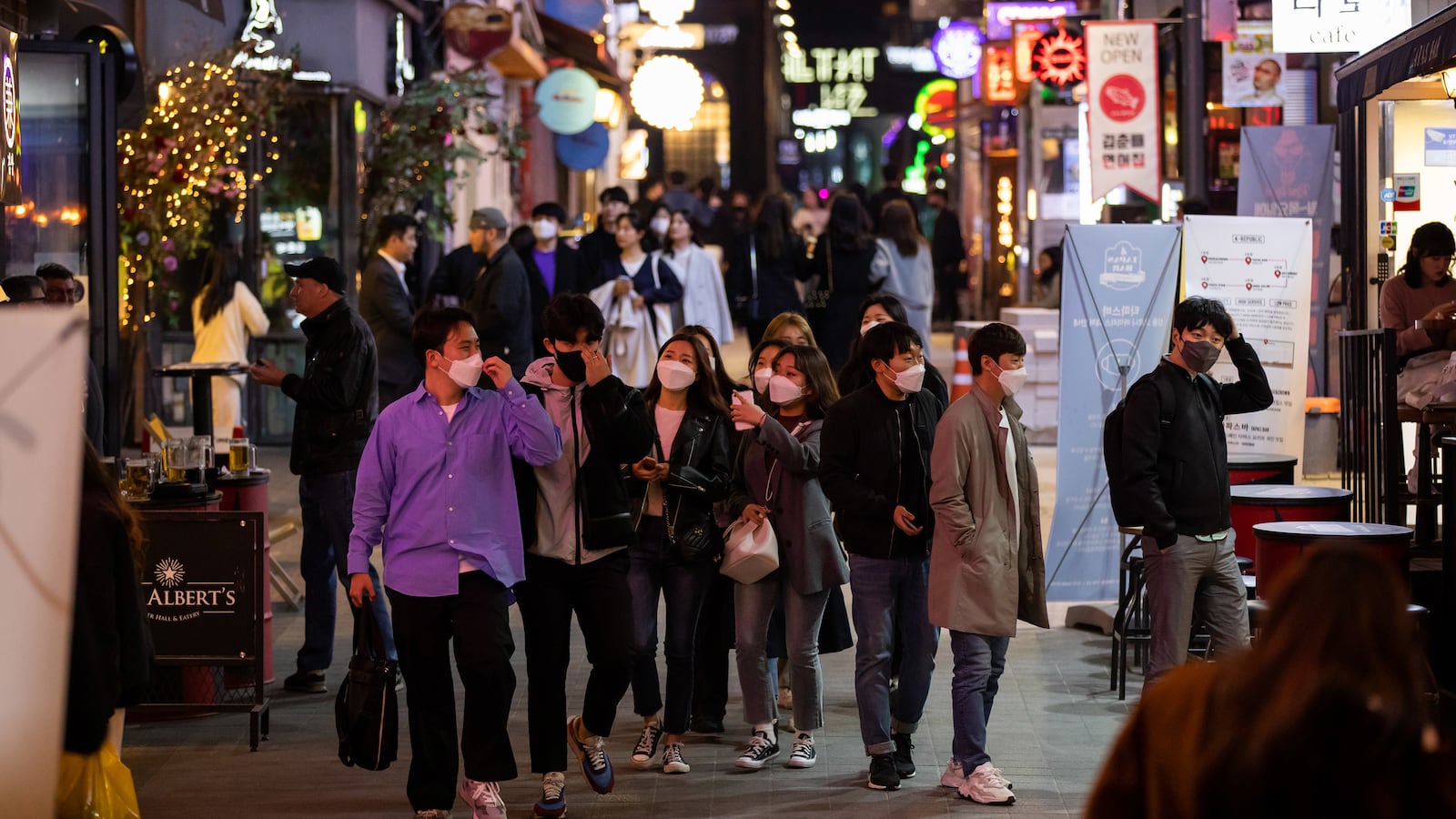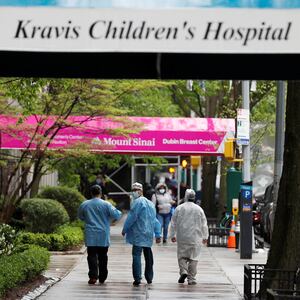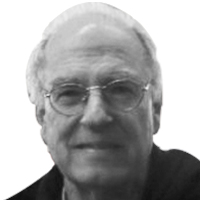This story was updated throughout the day on May 10, 2020.
SEOUL—South Koreans may be proud of their record relegating coronavirus to the status of a relatively minor menace, but the kind of voluntary social distancing called for now is hard. If anyone doubted that, a new outbreak in one of Seoul’s legendary nightclub districts provides an unsettling reminder.
South Korea never locked down the way many other countries have, but it did enforce strict rules to keep people from getting so close to each other that the novel coronavirus could run rampant.
The fresh outbreak that began last week started in gaudy clubs where the rules of common sense had been dissipating as the dangers of the coronavirus began to fade. No one was wearing masks, and social distancing had ceased to be a priority.
Now the search is on to find everyone who might have been in close quarters with one person who was diagnosed as having had COVID-19.
He was not identified publicly other than as the 29-year-old source of 54 cases, including three foreigners, diagnosed by Sunday. Most were traced to five clubs in Itaewon, the historic stomping ground of American GI’s from the former U.S. military headquarters near central Seoul, before spreading beyond the capital to the surrounding province, the nearby port city of Incheon and other parts of the country.
While the central government dithered, Seoul Mayor Park Won-soon was taking no chances. On Saturday, Park said bluntly anywhere people gather for fun and games in the evening had to shut down “immediately.” The order, he made clear, applied to nightclubs, bars, even the high-priced upscale “room salons” where young women entertain the rich and powerful.
Park had only to point to the example of the virus that originated in the bars of Itaewon as evidence that “carelessness can lead to an explosion in infections.”
The outbreak came as a severe disappointment for President Moon Jae-in, celebrating the third anniversary of his inauguration. While promising to “blaze a trail in the post-COVID-19 era” and extolling South Korea’s “rapid stabilization” of the disease, Moon had to acknowledge, “We are in a prolonged war,” and it would be “a long time before the outbreak has ended.”
In fact, officials feared the bug could spread among several thousand people who’d been at the clubs, which often are crowded late into the night.
The governor of the province surrounding Seoul ordered clubs not to entertain "crowds of people" to try to avoid "the balloon effect" of the virus spreading once again at exponential rates.
RELAXED, BUT NOT
The sudden upsurge haunted Koreans just as the government this week was going through the motions of relaxing its strict guidelines, counting on everyone to observe “voluntary social distancing in daily life.”
Somewhat ambiguously in the immediate aftermath of the incident, before the mayor acted, night club owners were advised to “restrict business” for one month. They were also asked to write down the names of all customers—invaluable for tracing future cases—and told that everyone had to be wearing face masks. Oh, and, if more cases did break out, owners would have to pay medical expenses.
By late Friday night, many owners and managers had gotten the idea. The bars were all closed and the often crowded main drag through Itaewon was bereft of its usual weekend traffic.
All of which supported the view of Son Young-rae, director of strategy at the Ministry of Health and Welfare, that we should expect the virus “inevitably to come back in daily activities,” though clearly he was not thinking so soon or so extensively.
Son, talking about removal of strict rules before the news of the nightclub incident had gotten around, was confident, “When we have a second outbreak, the speed of the spread will be remarkably slow.” Notice Son is not talking about if but when. A second surge is taken as a given.
The outbreak in Itaewon may not be enough to warrant restoring rigid formal rules, but officials are wary. Son’s superior, Kim Ganglip, vice health minister, said “when the social distancing campaign was in effect” an order on quarantine measures “was valid for nightlife establishments.” Now “we will see if additional measures are needed.”
For now, while owners of nightclubs are doing as told, voluntarily or not, ordinary folks can decide for themselves whether to stand six feet apart or wear face masks. Libraries and museums should be reopening, people can work out at fitness centers and go to movie theaters, and it’s up to customers not to crowd in line at cash registers.
But the Itaewon outbreak has raised serious questions about how far to take this relaxation of rules. Although schools are set to begin reopening on Wednesday, Health Minister Park Neung-hoo says Itaewon makes it “difficult to decide” whether to go through with the plan.
It’s hoped that everyone here knows enough by now to social distance almost instinctively—night club denizens notwithstanding. But there remain strict protocols in place for those entering the country from abroad.
QUARANTINED FOREIGNERS
Until the outbreak in Itaewon, at least half the new cases of the virus were blamed on passengers off international flights. Stringent testing remains in force at airports.
The results of the test come back usually after one night at a government facility. The vast majority are negative, but new arrivals are still quarantined for two weeks with friends or relatives or, if on their own, in a spartan room for two weeks at a cost of nearly $100 a day, including meals deposited in carefully wrapped packages outside doors.
The only exceptions are those on urgent business who plan to stay for just a few days. They can get a waiver from Korean embassies or consulates abroad after testing negative for the virus. So far only 200 people have gotten the waiver.
No matter what, Son had to admit, “it is impossible to terminate or remove COVID-19.” Rather, he said, “we can control the situation.”
At a virtual briefing for foreign correspondents for which they sent in questions, Son played up voluntary distancing even as coffee shops, stores, subways, and buses filled with rush hour crowds. The only sign that people were thinking seriously about COVID-19 was that most were wearing face masks.
Some, however, chose to let them slip down below their noses and mouths while a few were no longer bothering to wear them at all.
The Korean system was held up as an example before the world after the disease broke out in early February among members of a religious sect in Daegu, a major city 140 miles southeast of here. And it seemed to have been working quite well. As of Sunday, however, the Korea Centers for Disease Control reported 10,874 cases, up more than 50 from Friday and rising.
Still, according to Worldometer calculations, COVID-19 has killed only five out of every 1 million people in South Korea. By comparison, there are 242 deaths per million in the United States, where more than 80,000 people with the disease have died.
IMMUNITY STILL AN OPEN QUESTION
As South Korea tries to relax restrictions, it is not counting on the population developing immunity any time soon. Son was realistic about the simple fact there’s no cure yet for the virus and it’s going to frighten Koreans, and the rest of the world, for at least another year or two, maybe longer.
“Until we have a vaccine or cure, we can have a reappearance,” he said, citing the danger of the disease spreading from people who are asymptomatic—showing no signs of the illness and never tested. “It’s very difficult to root out.”
Son spoke before Korean mayors and governors gathered in an emergency session to talk about new guidelines for the nightclubs that were going strong, at least until last weekend. Those who had visited the King Club, Club Queen, and Trunk Club, all places where the latest “super-spreader” had been, were advised to quarantine themselves.
The possibility loomed of South Korea again imposing restrictions while Son and others defended the need for voluntary compliance rather than legal orders on social distancing and other common-sense strictures, including wearing face masks and washing hands.
Kwon Jun-wook, deputy director general at the Korea Center for Disease Control, counted on what he said would be the “etiquette of people entirely participating” in “the Korean spirit” but acknowledged, “We all agree that the COVID-19 world is very different from the past.”
He portrayed Koreans as banding together against the disease and saw very little chance of many if any suffering from relapses, or recurrence of the bug once they’ve been tested as cured.
On the basis of 300 cases so far in which tests have shown “reactivation of COVID-19,” he said, “there has not been infection or contagion.”
Laboratory analyses on “whether there’s a reactivated virus,” he explained, showed that “reactivation was not clinically significant.” In fact, while the virus was detected, there had “not been a single case” of anyone coming down with the disease that way.
Kwon seemed somewhat less certain about the level of immunity as determined by tests for antibodies capable of fighting the virus, but did say “we have a detailed plan” that depends on cooperation from the Korean public, 70 percent of whom “usually agree to public health testing.” One reason testing was readily accepted, he said, was a public health system in which all Koreans get extremely low-priced medical care.
An important element in the battle is plasma from patients who are ill. “Plasma can be developed for finding a cure,” he said, citing an ongoing “active investigation on developing plasma.”
Kwon was not optimistic, however, about coming up with the answer right away, or even this year or next. “We will have a concrete picture by next year,” he said, but noted that a vaccine to be administered to millions of healthy people requires much higher safety than experimental treatments carried out in a life-or-death effort simply to save a patient by whatever means might work.
TRACING AND TRACKING
Critical to Korea’s success so far, in Kwon’s view, was the decision to let people know what’s going on, and to track down, via cellphone signals and other means, every place anyone diagnosed with the disease has been.
“Openness and transparency didn’t just come alone,” he said. Only after the outbreak five years ago of the Middle East Respiratory Syndrome (MERS), in which 38 Koreans died, was a law passed that requires information sharing.
One result has been not only the willingness to cooperate but also the means to pass along warnings as soon as possible.
The words “emergency alert” show up on the screens of mobile devices whenever a case is discovered and diagnosed, as happened at least twice on Friday. The first notice did not give out the name of the person but did reveal where he or she lived and had been.
“COVID-19 developed with huge speed,” said Son Young-rae from the health ministry. “It was very important to carry out diagnostic tests actively."
By attacking the spread of the disease quickly and aggressively, however, South Korea never resorted to lockdowns and shutdowns as in the U.S. and Europe.
“We will keep monitoring and controlling the system,” Son said. “If the numbers are increasing, we will go back to the system we had in the beginning”: social distancing.
Not long after he spoke, millions of cellphones buzzed with another “emergency alert.” Anyone who had been in those nightclubs in Itaewon, the message advised, “should stay home.” Then, a day later, came alerts of new cases and word that all Seoul’s clubs and bars were shut tight.







